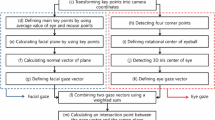Abstract
As gaze estimation research continues, the study can be classified into a 3D-based approach that estimates gaze orientation as an angle and a 2D-based approach that calculates the gaze position on a plane. That is, the 3D-based approach yields yaw and pitch, while the 2D-based approach yields the X and Y positions on the plane. Although research has been conducted for a long time, there is no way to compare gaze information calculated through each method. In order to calculate the 2D plane gaze position through yaw and pitch, the user's three-dimensional geometrical position information of face, camera, and the 2D plane should be considered in complexity. However, for the two approaches with the common purpose of gaze estimation, we believed that there would be a way to compare each other without complex three-dimensional considerations and complex calibrations. In this paper, we propose a method to accurately estimate the gaze position on a 2D plane through 2D geometric feature descriptor of face images for gaze orientation with machine learning. Experimental results on data in a laptop environment, the mean average error on X-axis was around 1.91 cm, and 0.71 cm on Y-axis, respectively.
Access this chapter
Tax calculation will be finalised at checkout
Purchases are for personal use only
Similar content being viewed by others
References
Shehu, I.S., Wang, Y., Athuman, A.M., Fu, X.: Remote eye gaze tracking research: a comparative evaluation on past and recent progress. Electronics 10(24), 3165 (2021)
Pathirana, P., Senarath, S., Meedeniya, D., Jayarathna, S.: Eye gaze estimation: a survey on deep learning-based approaches. Expert Syst. Appl. 199, 116894 (2022)
Liu, J., Chi, J., Yang, H., Yin, X.: In the eye of the beholder: a survey of gaze tracking techniques. Pattern Recogn. 108944 (2022)
Cheng, Y., Wang, H., Bao, Y., Lu, F.: Appearance-based gaze estimation with deep learning: a review and benchmark. ArXiv. (2021)
Roll, Pitch, and Yaw Edu. https://howthingsfly.si.edu/flight-dynamics/roll-pitch-and-yaw. Accessed 25 July 2022
Abdelrahman, A.A., Hempel, T., Khalifa, A., Al-Hamadi, A.: L2CS-Net: fine-grained gaze estimation in unconstrained environments. arXiv preprint arXiv:2203.03339 (2022)
Zhang, X., Sugano, Y., Fritz, M., Bulling, A.: MPIIGaze: real-world dataset and deep appearance-based gaze estimation. IEEE Trans. Pattern Anal. Mach. Intell. 41(01), 162–175 (2019)
MPII Face Gaze Dataset. https://www.mpi-inf.mpg.de/departments/computer-vision-and-machine-learning/research/gaze-based-human-computer-interaction/its-written-all-over-your-face-full-face-appearance-based-gaze-estimation. Accessed 25 July 2022
Acknowledgement
This research was supported by the ICT R&D innovation voucher project (No. 2022-0-00722) of the Ministry of Science & ICT of the Republic of Korea.
Author information
Authors and Affiliations
Corresponding author
Editor information
Editors and Affiliations
Rights and permissions
Copyright information
© 2023 The Author(s), under exclusive license to Springer Nature Switzerland AG
About this paper
Cite this paper
Lee, C., Kim, S., Lee, E.C. (2023). A Converting Model 3D Gaze Direction to 2D Gaze Position. In: Zaynidinov, H., Singh, M., Tiwary, U.S., Singh, D. (eds) Intelligent Human Computer Interaction. IHCI 2022. Lecture Notes in Computer Science, vol 13741. Springer, Cham. https://doi.org/10.1007/978-3-031-27199-1_34
Download citation
DOI: https://doi.org/10.1007/978-3-031-27199-1_34
Published:
Publisher Name: Springer, Cham
Print ISBN: 978-3-031-27198-4
Online ISBN: 978-3-031-27199-1
eBook Packages: Computer ScienceComputer Science (R0)




